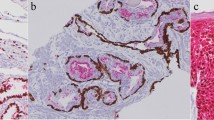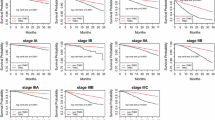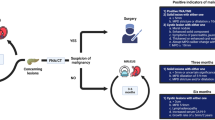Abstract
From 1970 to 1985, 663 patients underwent curative resection of colon and rectal adenocarcinomas. All surgical specimens were examined for tumor “budding,” defined as small clusters of undifferentiated cancer cells ahead of the invasive front of the lesion. Patients were divided into two groups according to degree of budding: none or mild (BD-1) and moderate or severe (BD-2). BD-1 occurred in 493 patients (74.4 percent), and BD-2 was found in 170 patients (25.6 percent). More severe budding was associated with worse outcome: 71.1 percent of BD-2 patients had recurrence, compared with 20.0 percent of BD-1 patients (P < 0.005). The five-year survival rate was worse in BD-2 than in BD-1 (22.2 percent vs. 70.7 percent;P < 0.001). The 10-year survival rate was also worse in BD-2 than in BD-1 (13.8 percent vs. 50.6 percent;P < 0.001). The incidence of BD-2 rose with the Dukes stage. However, the five-year survival rate of Dukes B patients with BD-2 lesions was worse than that of Dukes C patients with BD-1 cancers (29.1 percent vs. 66.2 percent;P < 0.001). Moreover, there was no difference in five-year survival among BD-1 patients with either Dukes B or C lesions (68.3 percent vs. 66.2 percent). The presence of more severe budding appears to indicate a vigorous biologic activity of colorectal cancer. Thus, meticulous follow-up—and possibly adjuvant chemotherapy—may be beneficial for patients with marked budding, regardless of their Dukes stage.
Similar content being viewed by others
References
Dukes CE. The classification of cancer of the rectum. J Pathol 1932;35:323–32.
Dukes CE, Bussey HJ. The spread of rectal cancer and its effect on prognosis. Br J Cancer 1958;12:309–20.
Jass JR, Love SB. A new prognostic classification of rectal cancer. Lancet 1987;6:1303–6.
Maruoka Y, Maetani S, Tobe T. Statistical analysis of pathologic factors influencing prognosis of colorectal carcinoma. Nippon Geka Gakkai Zasshi 1988;89:181–91.
Fielding LP, Phillips RK, Fry JS, Hittinger R. Prediction of outcome after curative resection for large bowel cancer. Lancet 1986;18:904–7.
Chapuis PH, Dent OE, Fisher R,et al. A multivariate analysis of clinical and pathological variables in prognosis after resection of large bowel cancer. Br J Surg 1985;72:698–702.
Jass JR, Atkin WS, Cuzick J,et al. The grading of rectal cancer: historical perspectives and a multivariate analysis of 447 cases. Histopathology 1986;10:437–59.
Rinnert-Gongora S, Tartter PI. Multivariate analysis of recurrence after anterior resection for colorectal carcinoma. Am J Surg 1989;157:573–6.
Ellis CN, Burnette JJ, Sedlak R, Dyas C, Blakemore WS. Prognostic applications of DNA analysis in solid malignant lesions in humans. Surg Gynecol Obstet 1991;173:329–42.
Hayashida K, Isomoto H, Shirouzu K,et al. A study of invasive colorectal carcinoma with reference mainly to vessel invasion and budding. Nippon Daicho-komonbyo Gakkai Zasshi 1987;40:119–26.
Morodomi T. Clinicopathological studies of advanced rectal cancers — predicting the degree of lymph node metastases from histopathological findings in pre-operative biopsy specimens. Nippon Geka Gakkai Zasshi 1988;89:352–63.
Hase K, Mochizuki H, Kurihara H,et al. Clinicopathological studies on local recurrence of rectal cancer. Nippon Shokakigeka Gakkai Zasshi 1989;22:1401.
Nakumura E, Hase K, Mochizuki H,et al. A study on prognostic value of tumor budding in patients with rectal cancer. Nippon Shokakigeka Gakkai Zasshi 1991;24:1631.
Gabbert H. Mechanism of tumor invasion: evidence from in vivo observations. Cancer Metastasis Rev 1985;4:293–309.
Broders AC. Squamous-cell epithelioma of the lip. A study of five hundred and thirty-seven cases. JAMA 1920;74:656–64.
Kokal W, Sheibani K, Terz J, Harada JR. Tumor DNA content in the prognosis of colorectal carcinoma. JAMA 1986;255:3123–7.
Kokal W, Gardine RL, Sheibani K,et al. Tumor DNA content in resectable, primary colorectal carcinoma. Ann Surg 1989;209:188–93.
Albe X, Vassilakos P, Helfer-Guarnori K,et al. Independent prognostic value of ploidy in colorectal cancer. Cancer 1990;66:1168–75.
Imai T. Histological comparison of cancer of the stomach in autopsy — and operation — cases. Jpn J Cancer Res 1949;40:199–201.
Imai T. The growth of human carcinoma. A morphological analysis. Fukuoka Igaku Zasshi 1954;45:72–102.
Imai T. Growth patterns in human carcinoma. Their classification and relation to prognosis. Obstet Gynecol 1960;16:296–308.
Enjoji M. On the changes produced in course of time in the histological picture of human carcinoma. Nippon Byorigakkai Zasshi 1958;47:203–20.
Yokota K. Carcinoma of the rectum: its histological picture and its postoperative course. Igaku Kenkyu 1957;27:2003–14.
Majima S, Karube K, Narisawa T, Hoshi H, Hiroki S. Clinical and pathological aspects of cancer of the colon in 193 cases—symptoms and pathological findings. Gan No Rinsho 1967;13:861–8.
Michelassi F, Ayala JJ, Balestracci T, Goldberg R, Chappell R, Block GE. Verification of a new clinicopathologic staging system for colorectal adenocarcinoma. Ann Surg 1991;214:11–8.
Author information
Authors and Affiliations
Additional information
Read at the meeting of The American Society of Colon and Rectal Surgeons, San Francisco, California, June 7 to 12, 1992.
About this article
Cite this article
Hase, K., Shatney, C., Johnson, D. et al. Prognostic value of tumor “budding” in patients with colorectal cancer. Dis Colon Rectum 36, 627–635 (1993). https://doi.org/10.1007/BF02238588
Issue Date:
DOI: https://doi.org/10.1007/BF02238588




